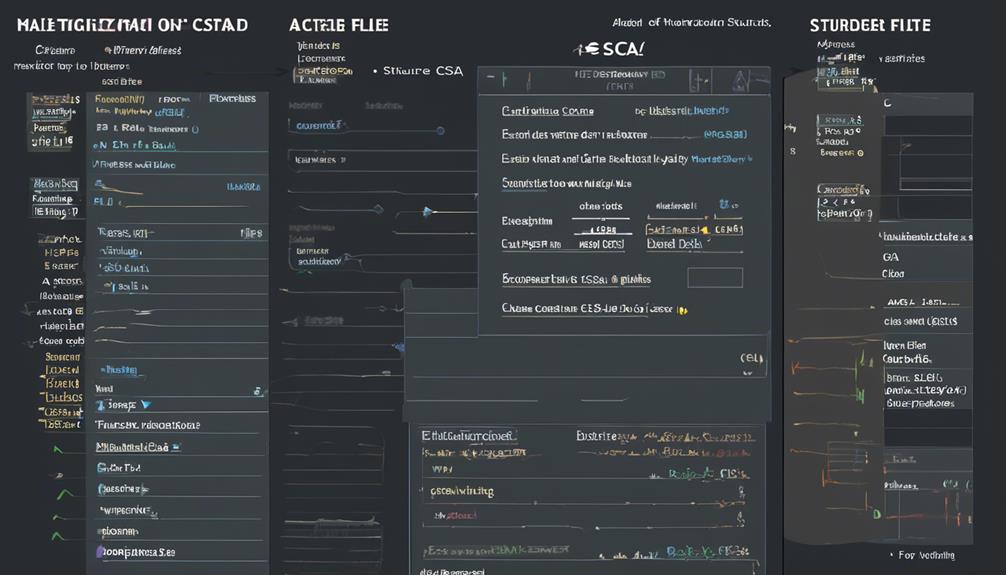To create an effective skills matrix for your QA team, start by listing core competencies like manual testing, automation scripting, and familiarity with tools such as Selenium or TestNG. Assess each team member’s proficiency levels honestly, from beginner to expert, and identify skill gaps. Use this overview to plan targeted training, close gaps, and optimize resource allocation. Continuing with these steps will help you build a stronger, more efficient QA team and improve testing outcomes.
Key Takeaways
- Define core QA competencies, including manual and automation testing skills, and establish proficiency levels for each.
- Assess team members honestly to identify current skill levels and skill gaps across the team.
- Use the skills matrix to allocate resources effectively and prioritize targeted training initiatives.
- Incorporate industry-standard tools, frameworks, and best practices to enhance automation and manual testing skills.
- Regularly update the matrix to reflect progress, new skills, and evolving industry trends for continuous team growth.

Have you ever wondered how to guarantee your QA team has the right skills to deliver quality software? Building an effective skills matrix is essential for identifying strengths and gaps within your team, ensuring you allocate resources wisely, and fostering continuous growth. One of the key areas to focus on is test automation. With the increasing reliance on automated testing, your team needs to be proficient in scripting, frameworks, and tools like Selenium, JUnit, or TestNG. By assessing each team member’s expertise in test automation, you can pinpoint who needs additional training and who can mentor others, streamlining your automation efforts. This targeted approach not only improves efficiency but also reduces the risk of manual testing errors slipping through.
Creating a skills matrix begins with mapping out the core competencies required for your QA processes. For test automation, list skills such as scripting languages, automation tools, CI/CD integration, and troubleshooting. For manual testing, skills like exploratory testing, test case design, and defect management are critical. Once these competencies are defined, evaluate your team members against each skill. Be honest and specific—use a scale or levels to rate proficiency, from beginner to expert. This transparency helps in setting clear development goals and identifying training needs.
Team training plays an important role in closing skill gaps highlighted by the matrix. Once you see where your team is lacking, you can plan targeted training programs, whether through online courses, workshops, or hands-on practice. Incorporate test automation training into your plans because automation can considerably speed up testing cycles and improve accuracy. Training should also include best practices, new tools, and evolving methodologies, so your team stays current with industry standards. Encouraging peer learning and mentorship can accelerate the learning process and foster a culture of continuous improvement. Additionally, understanding vetted tools and best practices can significantly enhance your team’s capabilities and confidence in their work.
Frequently Asked Questions
How Often Should I Update the Skills Matrix?
You should update your skills matrix regularly to support continuous learning and accurate skill tracking. Aim for at least quarterly updates, or whenever your team completes significant training or takes on new responsibilities. This guarantees you stay aware of your team’s evolving strengths and gaps. Regular updates foster ongoing development, help identify training needs, and keep your team aligned with project goals. Consistent review keeps your skills matrix a valuable, current resource.
What Tools Are Best for Creating a Skills Matrix?
Think of choosing tools for your skills matrix like selecting the right brush for a painting. You want tools that streamline your training methods and skill assessment. Platforms like Excel or Google Sheets are great for customization and simple tracking, while specialized tools like Skill Matrix or Trello offer visual dashboards and collaboration features. Pick the one that best fits your team’s size and complexity to keep your skills organized and up-to-date.
How Do I Handle Gaps in Team Skills?
When handling gaps in team skills, you should first identify the specific training gaps through assessments or feedback. Then, focus on team development by offering targeted training sessions, workshops, or mentorship programs. Encourage continuous learning and cross-training to build versatile skills. Regularly review progress, adjust development plans as needed, and foster an environment where team members feel supported in closing their skill gaps effectively.
Can a Skills Matrix Improve Overall Product Quality?
A skills matrix can definitely improve overall product quality by enhancing team development and skill assessment. When you identify strengths and gaps, you can tailor training and assign tasks more effectively. This targeted approach boosts team competence, reduces errors, and accelerates problem-solving. As a result, your QA team works more efficiently, catching issues earlier and ensuring a higher-quality product reaches your customers.
How Do I Measure the Effectiveness of the Skills Matrix?
To measure the effectiveness of your skills matrix, focus on performance metrics like defect detection rates, cycle times, and test coverage improvements. Conduct regular skill gap analysis to identify areas where team members need development. If you notice enhanced productivity, fewer bugs, and better test execution over time, your skills matrix is working well. Consistently tracking these indicators helps you determine its impact on your QA team’s overall performance.
Conclusion
By building a balanced, bold skills matrix, you boost your QA team’s capabilities and confidence. Continuously cultivating, checking, and charting each member’s competencies creates clarity and consistency. Keep key skills current, and cultivate collaboration to conquer challenges. With a carefully crafted, all-encompassing skills chart, you’ll confidently cultivate a cohesive, capable crew ready to conquer quality concerns and deliver exceptional results. Ultimately, a well-woven skills matrix will work wonders, welcoming growth and winning with unwavering excellence.









